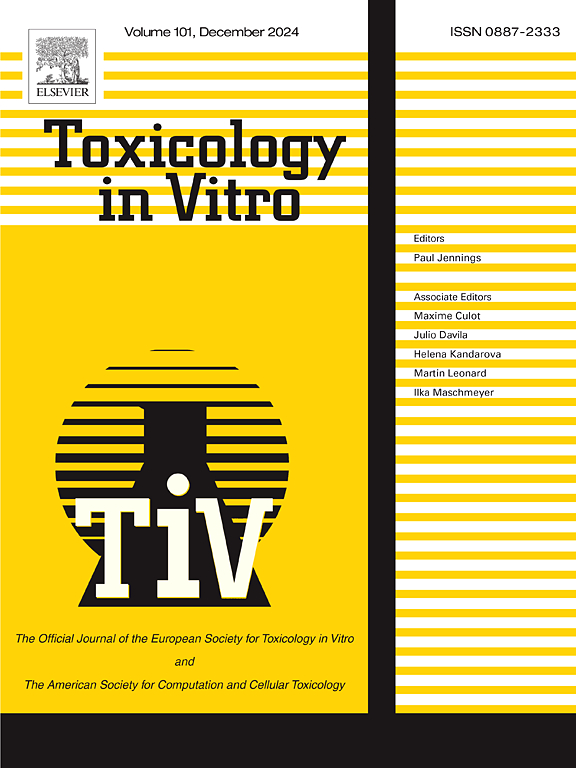e171诱导的人类ipsc衍生的结肠类器官毒性:对细胞活力、ROS生成、DNA损伤和基因表达变化的影响
IF 2.6
3区 医学
Q3 TOXICOLOGY
引用次数: 0
摘要
食品级二氧化钛(E171)是一种广泛使用的食品添加剂,安全性存在争议,特别是关于其基因毒性的影响。本研究评估了E171对人诱导多能干细胞(iPSC)衍生的结肠类器官的剂量依赖性毒性。将E171 (0.1 ~ 1000 μg/mL)暴露于类器官24 h,观察其对细胞活力、活性氧(ROS)生成、DNA损伤和基因表达的影响。结果显示,对细胞活力没有影响,但ROS形成呈剂量依赖性增加,在1000 μg/mL时达到峰值。电自旋共振光谱(ESR)显示,随着E171浓度的增加,ROS呈剂量依赖性增加。碱性彗星实验显示,当浓度为100 μg/mL时,DNA损伤显著;当浓度为10 μg/mL时,甲脒嘧啶DNA糖基化酶(FPG)检测到DNA氧化损伤。RNA测序鉴定出100和250 μg/mL浓度的差异表达基因(DEGs),这些差异表达基因与翻译活性、信号转导和DNA损伤修复有关。基因集富集分析(GSEA)显示核糖体、化学致癌- ros和代谢途径(碳代谢、糖酵解)被激活,而关键调控途径(Wnt、MAPK、PI3K-Akt)被抑制。这些发现表明,E171诱导氧化应激和DNA损伤,调节与代谢、增殖和癌症相关的转录组通路。需要进一步的研究来确定其对人体胃肠道健康的长期影响。本文章由计算机程序翻译,如有差异,请以英文原文为准。
E171-induced toxicity in human iPSC-derived colon organoids: Effects on cell viability, ROS generation, DNA damage, and gene expression changes
Food-grade titanium dioxide (E171) is a widely used food additive with debated safety, particularly regarding its genotoxic effects. This study assessed the dose-dependent toxicity of E171 in human induced pluripotent stem cell (iPSC)-derived colon organoids. Organoids were exposed to E171 (0.1–1000 μg/mL) for 24 h, and effects on cell viability, reactive oxygen species (ROS) generation, DNA damage, and gene expression were evaluated.
Results showed no impact on cell viability but a dose-dependent increase in ROS formation, peaking at 1000 μg/mL. Electrospin Resonance Spectroscopy (ESR) showed a dose-dependent increase in ROS, with increased E171 concentrations. The alkaline comet assay revealed significant DNA damage from 100 μg/mL, with oxidative DNA damage detected at 10 μg/mL using formamidopyrimidine DNA glycosylase (FPG). RNA sequencing identified differentially expressed genes (DEGs) at 100 and 250 μg/mL, linked to translational activity, signal transduction, and DNA damage repair. Gene set enrichment analysis (GSEA) indicated activation of ribosome, chemical carcinogenesis–ROS, and metabolic pathways (carbon metabolism, glycolysis), while key regulatory pathways (Wnt, MAPK, PI3K-Akt) were suppressed.
These findings suggest that E171 induces oxidative stress and DNA damage, modulating transcriptomic pathways associated with metabolism, proliferation, and cancer. Further research is necessary to determine its long-term effects on human gastrointestinal health.
求助全文
通过发布文献求助,成功后即可免费获取论文全文。
去求助
来源期刊

Toxicology in Vitro
医学-毒理学
CiteScore
6.50
自引率
3.10%
发文量
181
审稿时长
65 days
期刊介绍:
Toxicology in Vitro publishes original research papers and reviews on the application and use of in vitro systems for assessing or predicting the toxic effects of chemicals and elucidating their mechanisms of action. These in vitro techniques include utilizing cell or tissue cultures, isolated cells, tissue slices, subcellular fractions, transgenic cell cultures, and cells from transgenic organisms, as well as in silico modelling. The Journal will focus on investigations that involve the development and validation of new in vitro methods, e.g. for prediction of toxic effects based on traditional and in silico modelling; on the use of methods in high-throughput toxicology and pharmacology; elucidation of mechanisms of toxic action; the application of genomics, transcriptomics and proteomics in toxicology, as well as on comparative studies that characterise the relationship between in vitro and in vivo findings. The Journal strongly encourages the submission of manuscripts that focus on the development of in vitro methods, their practical applications and regulatory use (e.g. in the areas of food components cosmetics, pharmaceuticals, pesticides, and industrial chemicals). Toxicology in Vitro discourages papers that record reporting on toxicological effects from materials, such as plant extracts or herbal medicines, that have not been chemically characterized.
 求助内容:
求助内容: 应助结果提醒方式:
应助结果提醒方式:


